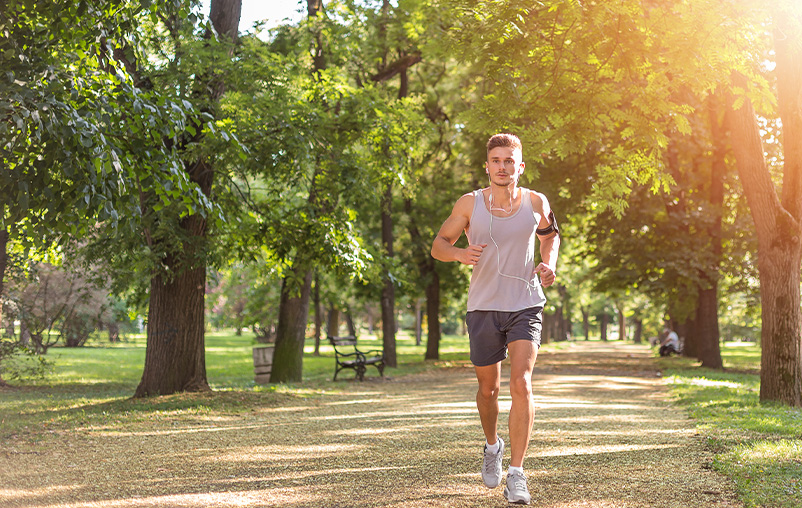Physical Activity & Fitness
Physical activity benefits people of all ages. Regular physical activity is one of the most important things you can do for your health, according to the Centers for Disease Control and Prevention (CDC).
Benefits of Physical Activity
Physical activity is all body movements that use or work your muscles to burn energy. Most people of all ages and abilities can enjoy physical activities like playing, biking, dancing, hiking, swimming, walking and playing sports.
You don’t have to be a serious athlete to get health benefits from being active. When you get regular physical activity, you may experience the following benefits:
- Better sleep
- Fewer health problems
- Improved balance and coordination
- Increased energy
- Less weight gain
- Reduced anxiety, depression and stress
- Sharper thinking, learning and judgment skills
- Stronger bones and muscles
Risk Factors
This CDC map data shows that 25% of U.S. adults are inactive, meaning they did not exercise outside of their regular job.
Some neighborhoods have no safe spaces to exercise or go for a walk. This makes it hard to stay active. People can be more active if they have safer, easier access to community facilities and programs.
Rates of physical activity also vary by age, gender, ethnic background, education and income level.
Differences in physical activity among race and ethnicity are common. According to the CDC map, rates of physical inactivity by race and ethnicity are:
- Non-Hispanic Asian: 20%
- Non-Hispanic White: 23%
- Non-Hispanic American Indian/Alaska Native: 29%
- Non-Hispanic Black: 30%
- Hispanic: 32%
Risks Associated with Physical Inactivity
Physical inactivity is linked to a higher risk of:
- Diabetes
- Heart disease
- High blood pressure
- High cholesterol
- Some cancers
- Stroke
- Weight gain
- Mental health conditions
Physical Activity by Age
The U.S. Department of Health and Human Services has Physical Activity Guidelines for Americans for how much physical activity children and adults need:
- Children ages 3-5 years = Active play daily throughout the day to enhance growth and development
- Children and teens ages 6-17 years = at least 60 minutes of exercise every day that makes them breathe harder and their heart beat faster
- Adults 18-65 and older = At least 150 minutes of moderate activity weekly
- Adults with chronic conditions or disabilities and those who are pregnant and postpartum should aim for at least 150 minutes of moderate aerobic physical activity weekly
- Talk with your primary care provider before starting a physical activity routine
- Examples of aerobic activities include cycling, dancing, hiking, jogging/long distance running, swimming and walking
Physical Activity & Fitness in Bexar County
In the 2022 Community Health Needs Assessment for Bexar County, 46% of adults reported exercising for at least 150 minutes weekly. This is better than the national average of 24%. About 27% of Texans are physically inactive, ranking Texas in the bottom third of U.S. states.
Children in central Bexar County are the least active while children residing on the north side are the most active.
University Health Resources
Primary Care
Primary care providers at University Health can help you create a plan to get physically active. Find a primary care clinic near you.
Fitness Center at the Texas Diabetes Institute
The University Health Fitness Center at Texas Diabetes Institute is open to all University Health patients with a doctor’s referral. It also hosts free daily exercise classes open to the public with no doctor’s referral needed.
FitLink
CareLink members of University Health can access the FitLink program at the Fitness Center at Texas Diabetes Institute. Staff assist CareLink members in improving their overall health and physical activity. Patients in CareLink receive a credit toward their financial balance for the fitness classes or gym time they complete.
Salud Por Vida (Health for Life) Program
Salud Por Vida is a 12-week health promotion program for CareLink members with diabetes or hypertension. The program offers six virtual workshops in English and Spanish. They cover diet, exercise, high blood pressure and diabetes. Workshops give patients a safe space to ask questions and avoid stigma.
Community Resources
Mobile Fitness
The Mobile Fit San Antonio vehicle visits parks, schools and community events throughout the year. It offers free fitness classes and health kiosk screenings. The physical activities include boot camps, aerobic exercise, yoga, Zumba and more. Health Kiosk Screenings help Bexar County residents learn about signs connected to health risks.
San Antonio Sports Activate
San Antonio Sports Activate is a free, virtual, and in-person program to help families learn about health and fitness. The program encourages families to get active and eat better. Every week, events take place throughout the city.
Free Exercise Class & Healthy Eating Options
The City of San Antonio Metropolitan Health District provides physical fitness and healthy eating guides online. Search for your district and download the available guide.

